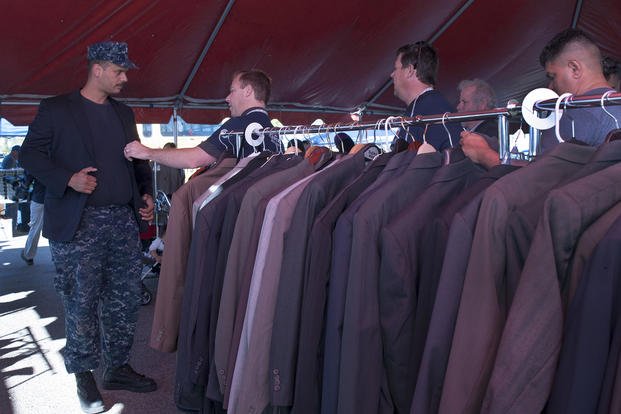Welcome home. As you join the rank and file of civilian life, one of your first moves will be to refresh those suits you mothballed when you enlisted. Or if you joined the services out of high school, you'll start building a business wardrobe for the first time.
When you go shopping for suits, you may notice that styles have changed in the past few years. The most significant change for suits is the emergence of the modern suit with its clean, tailored lines and slim fit, which mark a sharp departure from the traditional, roomier cut you may be accustomed to.
The modern suit flatters almost every body type, but before you run out and buy one, read this guide to determine what to look for in a suit.
1. Building a Functional Wardrobe
Building a professional wardrobe of suits is something that takes time. Think of it as a long-range project that will eventually result in a wide-enough selection that you'll look great in, in any situation, and won't rely too heavily on any single suit.
Your goal should be to build a two-week wardrobe. Why? Because a two-week rotation will give you enough wardrobe components to avoid a sense of repetitiveness. No, "Oh, he's wearing that again."
This rotation also allows enough time for one suit to be dry-cleaned or dropped off at your nearest Men's Wearhouse for free pressing and returned to your closet without having to make frequent trips to the cleaners. It will also allow your suits time to breathe and relax the effects of wrinkling, and it will help eliminate excessive wear, resulting in a longer life span for the garment.
While the number of suits you'll need will vary by profession, a good rule of thumb is that you should own at least one more suit than there are "suit" days in your week. So if your job requires wearing a suit four days a week, expect to own at least five of them.
2. What's Wrong with the Suits You Already Have?
A well-made suit has a lifespan of about five years. Even within that short time frame, however, styles change. It could be the lapel gets narrower, or it could be a more subtle change like the placement of vents. Today's designers favor flat-front pants without pleats, single-breasted styles and tapered legs.
If your current suits are more than a few years old, it's time to retire them and invest in a new wardrobe. Whether you're getting ready for a job interview or going to a wedding, you don't want to look out of date.
3. What Defines the Modern Suit?
The hallmarks of a modern suit are a cut that's slimmer through the torso, a narrower lapel, slightly shorter jacket and flat-front pants. (Pleated pants just don't work with this contemporary silhouette.)
Whatever your body type, you should be wearing the modern suit. You don't have to be ultra-thin to look good in it; it's a look that flatters all kinds of physiques. The body-contouring cut through the chest and midsection makes you look trimmer, no matter what your height or weight.
There are so many ways to personalize this new style of suit. You can pair your suit jacket with jeans instead of slacks or wear a separate vest instead of the jacket. You can roll your shirt sleeves up over your jacket sleeves. You can wear a hat or add a scarf. Have fun and make the look your own.
4. The Two-Button Silhouette
Two-button, single-breasted suits have been the dominant silhouette in American suiting for the past 80 years. Unlike three-button models, these suits are more immune to the whims of fashion, provided you select a two-button suit in a more conservative, traditional material (navy, charcoal, solids, pinstripes, etc.). The two-button suit is often referred to as the "single-breasted" suit, as it is considered the basic model of the single-breasted suit design.
Many men like that a two-button suit allows them to show off more of a shirt and tie, although in recent years, the top button of two-breasted models has been moving higher, bringing the silhouette closer to that of a three-button model. Many experts feel that old-style suits, with the buttons set low on the jacket, tend to accentuate the belly -- and no one wants that.
5. Double Down on Double Breasted?
Double-breasted suits were a power dressing essential in the late 1980s and early 1990s. That was the 20th century. Today, single-breasted styles dominate the market, as we're in a more traditional phase of the clothing fashion cycle.
If you're still tempted to dust off that double-breasted suit, the first thing you need to know is that your old double-breasted suit isn't going to cut it today. That's because the new double-breasted suits feature a markedly different design than their earlier cousins. Any double-breasted item in your closet not purchased within the last year is probably going to look out of style.
Many of today's double-breasted suits have side vents, as opposed to the non-vented style of the recent past. Also, these newer versions button differently than older styles. Some of the most recent double-breasted suits also include flat-front slacks, rather than the pleated models that were commonplace in days of old.
6. What to Look for If You're a Big and Tall Guy
If you're big and/or tall, buying a suit off the rack can be a confusing and challenging endeavor. Here's what you should be looking for:
Jacket Length
Suit jackets are usually sized by two factors: your chest measurement and your height. Generally, guys between six feet and 6 feet, 4 inches tall will need a long jacket. Guys 6-5 and taller may need to step it up to an extra-long size. But no matter what your height, the best way to find the right fit is by trying on several different styles. Standing straight, the jacket should be just long enough to cover your entire derriere.
Jacket Sleeves
A helpful way to determine a good fit is to wear a dress shirt under your suit jacket and stand straight with your arms hanging naturally by your sides. The jacket sleeve should hit at the bend of your wrist and show about a quarter-inch of your dress-shirt cuff. If the sleeves are a little short or a little long, a simple alteration should do the trick.
Jacket Waist
The jacket should be roomy enough that you can button it without any puckering or pulling across the chest. On the other hand, you shouldn't be able to fit much more than a fist under the buttoned jacket. If your jacket has vents (the vertical slits in the back), the flaps should lie flat and not stretch open.
Conclusion: There's No Substitute for Trying Them On
The only way to know which style of suit will work best is to try them on. It's not only a matter of what looks best, but also what feels best for you. Don't just stand in front of the mirror while you are deciding on a suit; move around, walk about the store, swing your arms.
No matter what kind of suit you're shopping for, the expert wardrobe consultants at Men's Wearhouse are always on hand to give you the advice you need to dress for success.
If you want to be taken seriously, you need to look your best. To get expert style advice on how to make the transition to civilian life, visit your local Men's Wearhouse, where our wardrobe consultants are on hand to give you the advice you need to dress for success.
Want to Know More About the Military?
Be sure to get the latest news about the U.S. military, as well as critical info about how to join and all the benefits of service. Subscribe to Military.com and receive customized updates delivered straight to your inbox.











